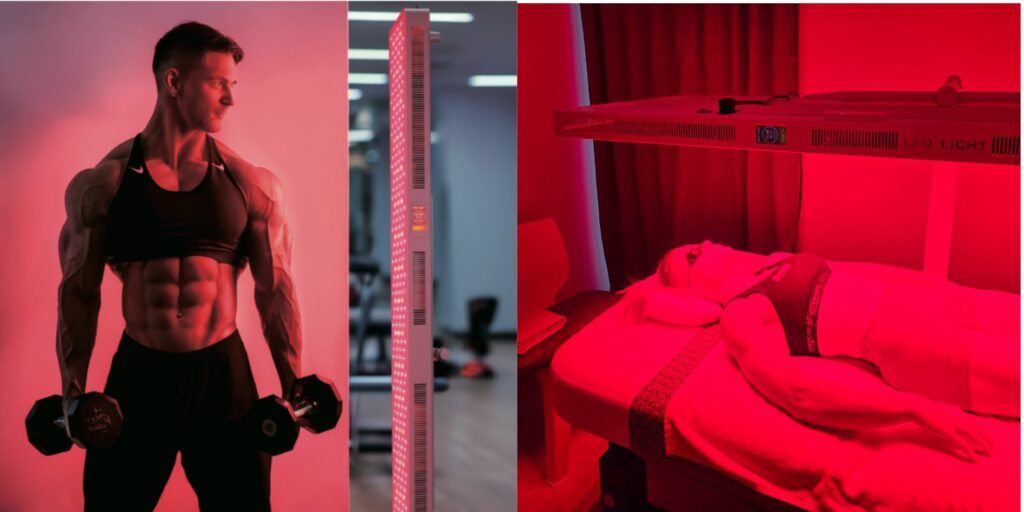Boost Recovery. Prevent Injuries. Perform Better.
How Photobiomodulation Boosts Performance, Speeds Recovery & Keeps You in the Game
Introduction
Whether you’re a weekend warrior or a professional athlete, red light therapy (RLT)—also called photobiomodulation (PBM)—is rapidly gaining traction as a game-changing recovery tool. By bathing muscles in specific wavelengths of red (600–700 nm) and near-infrared (800–900 nm) light, RLT supercharges your cells’ energy factories (the mitochondria), reduces exercise-induced damage, and helps you bounce back faster. No heat. No invasive procedures. Just a gentle glow that keeps you performing at your best.
Why Athletes Are Turning to Red Light
Intense training and competition inevitably lead to micro-injuries, inflammation, and oxidative stress, which can sap strength, slow recovery, and even raise injury risk. RLT tackles these issues at the cellular level:
- Enhanced ATP Production: Light photons are absorbed by cytochrome c oxidase, ramping up mitochondrial ATP synthesis. More ATP means more fuel for muscle contraction and repair.
- Reduced Oxidative Stress: Controlled bursts of reactive oxygen species activate your body’s antioxidant defenses, balancing inflammation without impairing performance.
- Improved Blood Flow: Light exposure promotes nitric oxide release, widening blood vessels for better nutrient delivery and waste removal.
What the Science Says
- Faster Muscle Recovery
In a 2022 trial with plyometric athletes, a combination of 630 nm (red) and 940 nm (NIR) light delivered immediately after exercise reduced markers of muscle damage and soreness without blunting adaptive gains in strength and power pubmed.ncbi.nlm.nih.gov. - Performance Gains When Applied Before Exercise
A landmark meta-analysis concluded that pre-exercise phototherapy (using both laser and LED devices) consistently improved muscular performance and accelerated post-activity recovery across multiple sports modalities—particularly when applied 5–15 minutes before training pubmed.ncbi.nlm.nih.gov. - Endurance & Metabolic Efficiency
A double-blind, randomized crossover trial in cyclists (averaging 460 km/week training) found that PBM improved oxygen uptake kinetics and delayed time-to-exhaustion by nearly 12% during successive sprint efforts—suggesting real-world endurance benefits mdpi.com. - CrossFit® Athlete Recovery
In CrossFit® competitors, combining PBM with a static magnetic field (PBMT-sMF) at strategic time points (pre-, mid-, or post-workout) led to lower blood markers of muscle damage (creatine kinase) and inflammatory cytokines, helping athletes feel fresher for their next WOD pubmed.ncbi.nlm.nih.gov.
Practical Protocols for Athletes
Based on current evidence and common practice among performance centers, here’s a simple RLT routine:
| Timing | Wavelengths | Dose (Fluence) | Session Length |
|---|---|---|---|
| Pre-Workout | 660 nm + 810 nm NIR | 4–6 J/cm² per muscle group | 5–10 minutes |
| Post-Workout | 630 nm + 850 nm NIR | 10–20 J/cm² total | 10–15 minutes |
| Frequency | — | — | 3–5 times per week |
Tip: Keep the device 10–20 cm from skin and move slowly to cover the entire muscle belly.
Real-World Benefits You’ll Notice
- Less Soreness & Stiffness: Many athletes report a 30–50% reduction in delayed-onset muscle soreness (DOMS) after just one week of RLT sessions.
- Quicker Return to Training: Reduced inflammation and faster tissue repair can shave days off your recovery timeline.
- Improved Strength & Power: Studies show small but meaningful gains in peak torque and jump height when using PBM before resistance sessions.
- Lower Injury Risk: By fortifying muscles against oxidative damage, RLT may help prevent overuse injuries over the long haul.
Integrating RLT into Your Training Plan
- Combine with Traditional Recovery: Use RLT alongside foam rolling, massage, and proper nutrition for a full-spectrum approach.
- Tailor to Your Sport: Focus on the most taxed muscle groups (e.g., quads for runners, shoulders for swimmers).
- Monitor & Adjust: Track your soreness, performance metrics, and overall energy. You may dial dose and frequency up or down based on response.
- Consistency Is Key: Like strength training, the benefits of RLT accumulate—regular use yields the best results.
What to Look for in an RLT Device
- Dual Wavelengths: Devices combining red (~660 nm) and NIR (~810–850 nm) deliver comprehensive benefits.
- Sufficient Power: Aim for at least 50 mW/cm² irradiance to achieve therapeutic doses within practical session times.
- Beam Uniformity: Flat-top or panel designs ensure even coverage and predictable results.
- Ease of Use: Portable panels or handheld devices with timers simplify integration into busy training schedules.
Conclusion
Red light therapy is more than a trendy gadget—it’s a scientifically backed tool that empowers athletes to train harder, recover faster, and stay in peak form. By boosting cellular energy, reducing damage, and enhancing blood flow, PBM offers a non-invasive edge for anyone serious about performance.
Whether you’re aiming for a personal best, speeding through rehab, or simply craving more resilient muscles, red light could be the missing piece in your training arsenal.
✅ Next Steps: Speak with a ZenGlow specialist to design a customized RLT protocol for your sport, facility, or home gym—and see firsthand how light can power your peak performance.
Sources

